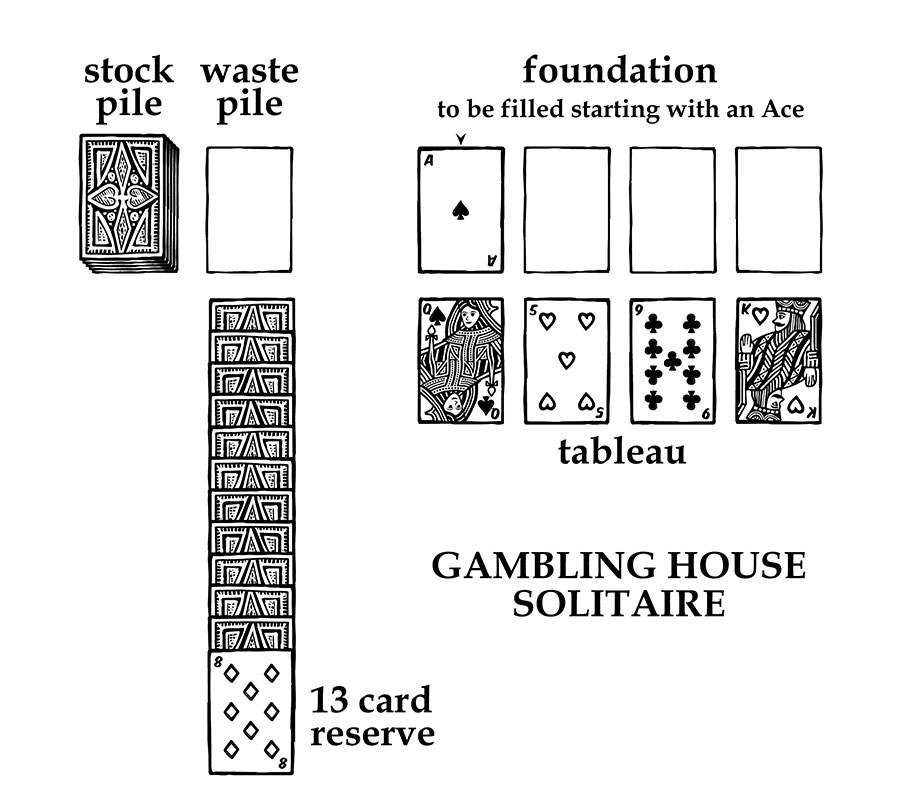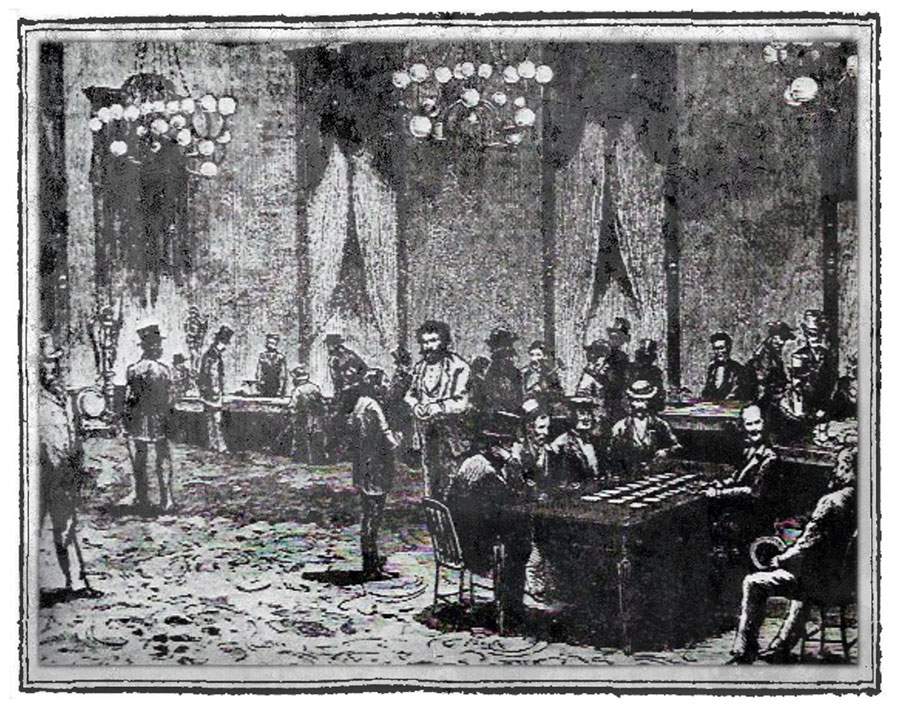Gambling House Solitaire is a solitaire that was played in America in 1902 in Gambling Houses in Chicago and New York. This form of Solitaire is nowadays better known as Canfield Solitaire, named after Richard Albert Canfield, who ran several gambling houses in New York at the end of the 19th century.
But did you know that this game wasn’t initially called Canfield Solitaire? “Gambling House Solitaire” seems to be the only correct name. Here is how you play it:
Gambling House Solitaire Rules
Gambling House Solitaire is played with a deck of 52 cards (no jokers).
The game’s rules essentially correspond to the game we call Demon, Fascination, or Canfield Solitaire but with some essential differences which I will point out in this article.
The Object of the Game
The object of Gambling House Solitaire is to make a profit by sorting as many cards as possible by suit, starting with the Ace and ending with the King of each Suit. A payout follows for each card the player can play to the Foundation, where the four Ace-starter piles are located.
Start of the game/buy-in
The player buys a deck of cards for $52 or $1 each. There was also an option to play for lower stakes, but the rate was always equal to the above bet ratio (x5.)
Dealing and Cutting the Cards
The game is played with real cards under the supervision of a so-called attaché (dealer). An attaché (game supervisor) is assigned to the player and ensures fair play. The player is handed the deck of cards, which he must then shuffle himself thoroughly. The attaché then cuts the deck, and the cards are dealt as follows:

- First, thirteen cards are counted and placed face down on the table. (Reserve)
- The following four cards are dealt face up. These are called the base maps. (Tableau)
- The rest of the cards are placed in a pile above the Reserve or kept in the left hand as before. (Stock)
Gambling House Solitaire Gameplay
One main difference in this version of Solitaire is the focus on playing Reserve cards first. When the game begins, the top card of the Reserve is turned face up. This is available to play according to the applicable rules. When this has been played, the next card from the Reserve may be turned over.
- The cards from the deck, “Stock,” or those that the player is holding in his left hand, may be turned over in sets of 3, with the top card always available to play.
- You can play cards from the Reserve or the Stock directly to the Foundations or any of the four rows of the Tableau.
Rules regarding moving the cards
Foundation:
- Cards should be sorted by suit and ascending order.
Tableau:
- Cards must be moved alternately, red on black and in descending order. (e.g., Queen under King, Jack under Queen)
- When the bottom card of a Tableau pile is played to another pile of the Tableau, the entire pile is moved, leaving an empty space.
- To fill an empty space, you must play the (top) face-up card of the Reserve. If the Reserve has already been used up, you must play the top face-up card from the pile to fill the space.
- Playing a card back from the Foundations to the Tableau is not allowed.
Gambling Solitaire Payout
There are 2 different ways that Gambling Solitaire can be played in terms of payout, either as a single game or in a series of 5 games.
In most gambling houses, Gambling House Solitaire was only offered in a series of 5 games:
- The player buys in for five games at $52 per deck or a derivative thereof.
- When the player has managed to put away a total of 52 cards on the foundations after the five rounds, he plays “break-even” for every card he puts away more, and the player is paid $5 (or a derivative thereof).
- If the player manages to get rid of fewer than 52 cards, he loses all 5 of his bets.
In a single game, the above score only applies per game. So you buy in for $52, and you receive $5 per card you manage to play away. At 11 cards, you play break-even, and anything above that is a win.
In some gambling houses, you got a bonus when you cleared all the cards. Depending on the gambling house, this bonus amounted to $500 or 1000 dollars.
Gambling House Solitaire History
The term Gambling House Solitaire dates from 1902, and we have come across it in various American newspaper articles. According to the articles, the game is referred to as Gambling House Solitaire, and it was popular in gambling houses in Chicago and New York.
According to many books about Solitaire, this game was invented by Richard Albert Canfield. He is said to have named the game after himself and offered it at one of his gambling houses. However, by 1902, Canfield’s gambling houses in New York were all but one closed. He still ran his clubhouse in Saratoga Springs, but, despite many detailed reports from the past, nothing specific has been written about Solitaire being played here.
On the contrary, according to reasonably reliable sources (including the author of his biography), Canfield would never have had anything to do with the game of Solitaire.

Read more about Gambling House Solitaire
Resources:
- Gambling House Solitaire is popular in Brooklyn – The Brooklyn Daily Eagle – 1902
- Solitaire Gambling, new game, looks easy, but it costs piles of money – News Journal – 1902
- Gambling with Solitaire – Chicago Daft Now over a game that seems easy but is not – The Sun New York – 1902